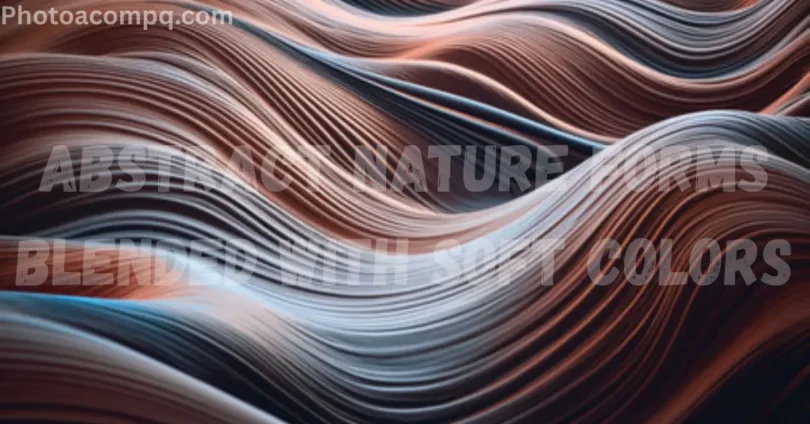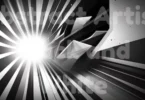Abstract Nature Forms Blended With Soft Colors: Art has always been a way for humans to express feelings, dreams, and imagination. Abstract art is a special type of art because it does not show things exactly as they look in real life. Instead, it uses shapes, colors, lines, and textures to create a feeling or an idea. When abstract art is mixed with nature, it becomes even more powerful. Nature already gives us endless beauty through trees, mountains, rivers, flowers, and skies. When artists take these natural elements and turn them into abstract forms, they create artwork that looks magical and full of emotions.
Soft colors play a very important role in this style. Bright colors can sometimes feel too strong or loud, but soft colors like pastels, creams, and light shades bring peace, calmness, and balance. This is why “Abstract nature forms blended with soft colors” has become such a popular style in modern art. It gives people a sense of harmony and relaxation.
The Concept of Abstract Forms
Before we can understand this art style, we need to know what abstract forms are. Abstract forms are shapes and patterns that do not look exactly like real-life objects. For example:
- A tree may be shown as a swirl of green lines.
- A mountain may look like a triangle with soft edges.
- Water may appear as wavy blue strokes.
Instead of copying nature exactly, abstract artists create their own version. They play with lines, curves, dots, and textures. The goal is not to show the real object but to capture its “feeling.”
This is why abstract forms are so special. They allow every person to see something different in the same painting. One person may see a flower, while another may see sunlight. This makes abstract nature art unique and personal.
The Role of Soft Colors in Abstract Art
Colors are the heart of abstract nature art. But not just any colors—soft colors. These include:
- Light blues (like the morning sky)
- Pale greens (like young leaves)
- Pastel pinks (like soft flowers)
- Gentle yellows (like sunshine)
- Cream, beige, and light gray tones
Soft colors are important because:
- They create calmness instead of stress.
- They show peace and balance.
- They connect with nature’s softness, like mist, clouds, and morning dew.
Artists use these colors to make sure their artwork feels relaxing. Unlike bold and dark shades, soft colors let the viewer breathe and feel comfort.
Nature as an Endless Inspiration
Nature has always been the biggest source of inspiration for artists. Every tree, river, flower, or mountain has its own story. Abstract artists do not try to copy these things exactly. Instead, they turn them into forms and colors.
Some common natural elements in abstract art are:
- Trees – shown as flowing lines or spiral forms.
- Mountains – drawn as triangles, layers, or soft textures.
- Rivers and seas – created with smooth curves and waves.
- Sky and clouds – painted with soft blue and white blends.
- Flowers – represented through dots, circles, or swirls.
Nature never ends. It changes every season and every moment, which means artists always find new inspiration.
Techniques for Blending Abstract Forms with Soft Colors
Artists use different techniques to create this style. Some of the most popular methods are:
- Brush techniques: Using small strokes for texture and smooth strokes for soft blends.
- Layering: Applying colors in layers so they mix gently without looking harsh.
- Blending tools: Using sponges, cloth, or fingers to soften edges.
- Digital art tools: On computers, artists use gradient tools, blur effects, and soft brushes.
- Mixed media: Combining paint, pencil, fabric, or even natural items like leaves to create unique textures.
These techniques help to create balance between the abstract forms and the soft colors.
Symbolism Behind Abstract Nature with Soft Colors
Abstract art is not only about beauty. It also carries meanings and emotions. For example:
- Soft blue – peace, trust, sky, and water.
- Light green – growth, nature, and freshness.
- Pastel pink – love, care, and softness.
- Yellow – happiness, sunshine, and hope.
- White and cream – purity, peace, and calmness.
Abstract forms also have hidden meanings:
- A circle may represent wholeness.
- A wave may show movement and life.
- A triangle may symbolize strength.
By blending forms and colors, artists can tell stories without using words.
Popular Styles and Movements
Abstract nature with soft colors is not a new idea. It has connections with different art styles:
- Impressionism – Focused on light, color, and soft brushstrokes.
- Minimalism – Simple shapes and limited color palettes.
- Contemporary abstract – Modern artists use digital and traditional tools to create unique blends.
- Zen-inspired art – Focuses on peace, calmness, and balance with nature.
This style has grown popular in the 21st century, especially in home décor and modern design.
Practical Uses of Abstract Nature Art
This art style is not just for galleries. It is used in everyday life:
- Home décor: Wall paintings, wallpapers, and furniture designs.
- Fashion: Soft-colored abstract prints on clothes, scarves, and accessories.
- Digital design: Website backgrounds, app designs, and digital posters.
- Stationery: Notebooks, calendars, and greeting cards.
- Meditation spaces: Used to create calm and peaceful environments.
Because it is soft and relaxing, this art style works everywhere.
How to Create Your Own Abstract Nature Artwork
Anyone can try this style at home. Here’s a simple guide:
- Choose inspiration: Pick a natural element like a tree, flower, or river.
- Select colors: Use soft shades like pastels, creams, or light blues.
- Make abstract forms: Instead of copying the real object, use simple shapes.
- Tree = lines and swirls
- River = wavy curves
- Flower = circles and dots
- Blend softly: Use brushes, sponges, or digital tools to soften edges.
- Add meaning: Think of what emotion you want to show.
- Finish with balance: Make sure the artwork feels calm and not too crowded.
This way, even beginners can make their own abstract art.
Common FAQs About Abstract Nature Forms Blended With Soft Colors
Some faqs of Abstract Nature Forms Blended With Soft Colors:
1. What does “abstract nature art” mean?
It means using nature as inspiration but showing it in abstract forms like shapes, lines, and colors instead of realistic drawings.
2. Why are soft colors used in abstract art?
Soft colors give peace, calmness, and harmony, making the artwork feel gentle and relaxing.
3. Can beginners make abstract nature art?
Yes, beginners can start with simple shapes and soft colors. Abstract art has no strict rules.
4. What materials do I need to create this art?
You can use brushes, paints, sponges, digital tools, or even mixed media like fabric and paper.
5. Is abstract nature art popular in home décor?
Yes, it is very popular because it matches modern interiors and creates a peaceful atmosphere.
6. How is digital abstract art different from traditional painting?
Digital art uses computer tools for blending, while traditional art uses brushes and paint. Both can be beautiful.
7. What emotions can abstract nature art show?
It can show peace, love, calmness, happiness, balance, or even energy depending on colors and forms used.
8. Which colors are best for this style?
Pastels like light blue, pale green, soft pink, yellow, cream, and beige are commonly used.
9. Can abstract nature art be used in fashion?
Yes, many designers use abstract soft-colored patterns on clothes, scarves, and bags.
10. Why do people love this art style today?
Because it is simple, calming, and makes spaces look modern and relaxing.
Conclusion
Abstract nature forms blended with soft colors are more than just paintings. They are a bridge between imagination and reality. They remind us of the beauty of nature but show it in a new way calm, soft, and emotional.
This style is loved today because it helps people relax, heal, and connect with nature. In a fast world full of stress, soft-colored abstract art gives peace and comfort.


